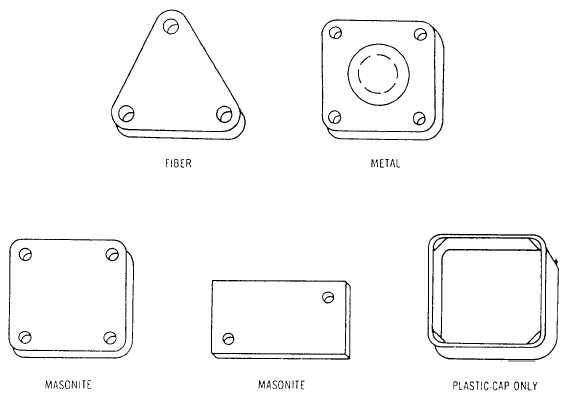Figure 2-52.—Typical blank-off plates.
Figure 2-52 shows typical blank-off plates. In all
cases where there is a choice between an internal or
external installation, use the external type of closure.
Use metal protective closures to seal open ports of all
hydraulic lines and accessories. Use metal protective
closures to seal new and reusable hydraulic tubing
and hose assemblies. Plastic closures may be used to
seal electrical fittings and receptacles or other
nonfluid openings where contamination is not
considered a problem.
Keep all protective closures
clean, sorted by size, properly identified, and stored in
readily accessible bins.
Check protective closures
visually for cleanliness, thread damage, or sealing
deformation before using.
Rubber, plastic, or unthreaded type of protective
closures designed to fit over open ends of bulk hose
and tubing should be used in accordance with design
function only. Do not use this type of protective
closure as a plug for insertion into open lines, hoses,
or ports of hydraulic equipment. Remove protective
closures before installing equipment. If an opening
normally requiring protection is found uncovered, the
part or assembly should be cleaned and checked
before installation or assembly.
AIRCRAFT ELECTRICAL SYSTEM
HARDWARE
Learning Objective: Recognize the difference
types of common electrical hardware used on
naval aircraft.
An important part of aircraft electrical mainte-
nance is determining the correct type of electrical
hardware for a given job. These maintenance
functions normally require a joint effort on the part of
the AM and the AE/AT personnel. You must become
familiar with wire and cable, connectors, terminals,
and bonding and bonding devices.
WIRE AND CABLE
For purposes of electrical installations, a wire is
described as a stranded conductor covered with an
insulating material.
The term cable, as used in
aircraft electrical installations, includes the following:
. Two or more insulated conductors contained in
the same jacket (multiconductor cable)
. Two or more insulated conductors twisted
together (twisted pair)
2-42

